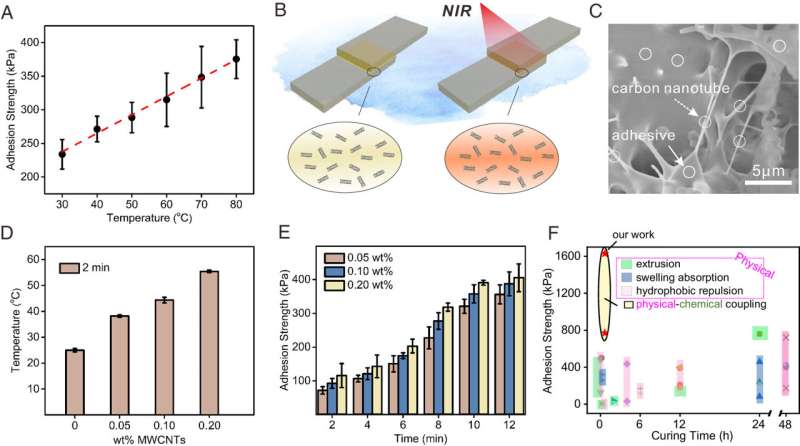This article has been reviewed according to Science X's editorial process and policies. Editors have highlighted the following attributes while ensuring the content's credibility:
fact-checked
peer-reviewed publication
trusted source
proofread
Researchers achieve water-assisted strong underwater adhesion

As the interfacial water layer hinders the formation of interfacial contacts and intermolecular interactions between the adhesive and the substrate, in almost all cases of underwater adhesion, water molecules typically act as a destroyer, resulting in poor adhesion. Thus, removing interfacial water from the substrate surfaces is essential for the formation of super-strong underwater adhesion.
Despite various single physical attempts such as absorption, hydrophobic repulsion and extrusion, the complete removal of interfacial water contradiction is hard to achieve because of the unavoidable presence of bound water at the interface. Hence, an unconventional dehydration mechanism with a conceptually new material design at the physical-chemical coupling and a multiscale method are required for deep removal of water at the contact interface and self-adaptive cohesion enhancement to create powerful underwater adhesives.
In a study published in PNAS, Zhou Feng's group from the Lanzhou Institute of Chemical Physics (LICP) of the Chinese Academy of Sciences developed a self-strengthening liquid underwater adhesive (SLU-adhesive) and achieved fast and robust underwater adhesion through deep-water removal at the contact interface and self-adaptive cohesion enhancement.
The researchers utilized a multiscale dehydration mechanism based on a physical–chemical coupling to develop the SLU-adhesive. The adhesion mechanism of the removal of interfacial water involves multiscale dehydration in three steps, namely, physical replacement of the surface water on the substrate with SLU-adhesive at mm scale because of its excellent wettability, physical removal of water at μm scale by generating carbon dioxide bubbles from the chemical reaction between isocyanate groups and water at the interface, and simultaneous chemical consumption of the surface-bound water at molecular level.
This series of adhesion behaviors is instantaneous, spontaneous, and tacitly coordinated throughout the entire process of liquid adhesive contact, spreading, wetting, and gelation on the substrate surface. Strong adhesion over 1,600 kPa can be achieved on various materials, including inorganic metals and organic plastic materials, without preloading in different environments such as pure water, a wide range of pH solutions (pH = 3 to 11), and seawater.
Due to their excellent adhesion property and self-adaptive adhesion procedure, SLU-adhesive materials demonstrate great potential for a wide range of applications in underwater sand stabilization, underwater repair, and even as a self-reporting adhesive for the detection of adhesion failure.
More information: Chenxi Qin et al, Water-assisted strong underwater adhesion via interfacial water removal and self-adaptive gelation, Proceedings of the National Academy of Sciences (2023). DOI: 10.1073/pnas.2301364120
Journal information: Proceedings of the National Academy of Sciences
Provided by Chinese Academy of Sciences





















